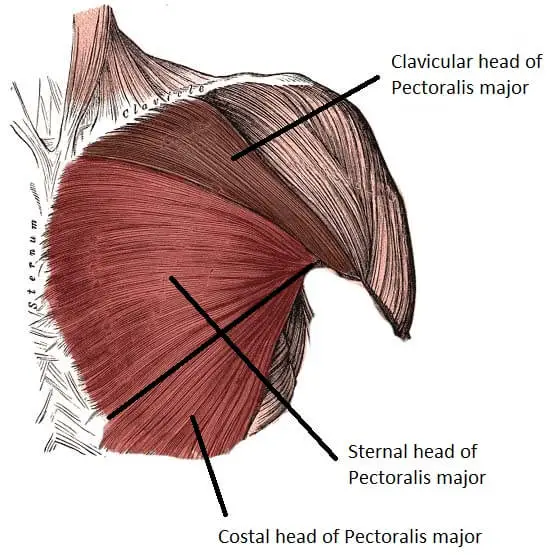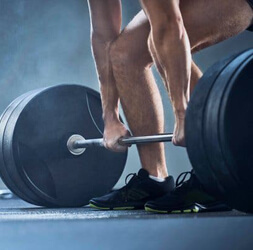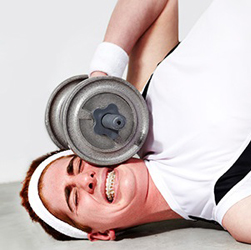Home / Workout Tips / 15 Exercises For An Awesome Upper Chest Workout
15 Exercises For An Awesome Upper Chest Workout
20/01/2020share
tweet
share

15 Exercises For An Awesome Upper Chest Workout
For many:
Building a decently-sized chest is no problem.
The issue lies where specific parts of your chest begin to grow more than others and muscular imbalances start to creep in.
How so?
It’s common for your upper chest to lack development as standard (and more popular) exercises such as the flat bench press and push ups take precedence and are great foundational exercises for mid- and lower chest growth.
However,
Most don’t consider training their upper chest specifically which leads to an overall disproportionate chest.
We’re here to fix that.
We’ve put together ag of the most hard-hitting upper chest exercises to try on your next upper chest workout to help build out your chest as a whole…
And given time, these exercises will leave you with that full armour plated look making you look like a superhero by the beach or pool.
Let’s get to it.
But first…
The Science Stuff
Before we dive into the best exercises to try on your next upper chest workout, it’s important to understand the anatomy of the overall chest and where greater emphasis needs to be placed.
Your chest is made up of the pectoralis major which forms the ‘bulk’ of the muscles found in your chest.
It is divided into two parts:
The clavicular head of pectoralis major (commonly referred to as the ‘upper pec’) and the sternocostal head of the pectoralis major (widely known as the ‘mid’ and ‘lower pec’).
See below:

From the image above, you can see that the clavicular muscle fibers sit at a different angle compared to the rest of the chest which is why they need to be worked differently.
Thus,
It probably comes at no surprise that the mid- and lower region of your chest are ‘somewhat’ easier to develop due to being involved in more common chest exercises such as the flat and decline bench press.
As a result, this can lead to your upper chest being overshadowed by the increased development of the pectoralis major.
This is why research suggests training your upper chest muscles at an inclined angle to emphasise the direction in which the muscle fibers naturally move.
It also goes without saying:
Having a well developed upper chest not only creates a ‘fuller’ overall upper body, but it can also help increase overall strength on compound exercises such as the bench press and overhead press.
Don’t forget,
Although the muscle fibers move in a different direction, its connective tissue is still part of the pectoralis major which will benefit other movements and exercises.
Upper Chest Exercises with a Barbell
Incline Barbell Bench Press

If you’re looking to develop a fuller upper chest, you’ll have to perform a lot of incline-based chest exercises. Period.
With that said:
The Incline Barbell Bench Press is arguably the ‘granddaddy’ of all upper chest exercises.
Why?
Not only does it target your upper chest, but your shoulders, triceps, lats and even your legs (to a certain extent) come into play.
It’s no wonder bodybuilding legends like Arnold Schwarzenegger, Reg Park and Franco Columbu used this exercise as a staple during their upper chest workout winning numerous world championships between them in the process.
One advantage a Barbell Bench Press has over a Dumbbell Bench Press is the ability to move up in weight in smaller increments.
For instance,
It’s a lot easier to lift an additional 2.5kg in weight each time (1.25kg both sides) using a barbell then it is lifting an extra 4kg (2kg each side) with dumbbells that are commonly found in most gyms.
However, although a barbell only allows for a fixed range of motion, holding the weight against your chest for a few seconds will allow greater muscle fiber recruitment on your upper chest for a better workout.
How to perform:
· Ensure a bench has been set between 30 – 45 degrees
· Lie on the bench with your eyes directly under the bar
· Slight raise your chest up and gently squeeze your shoulder blades together ensuring they’re tucked down.
· Grab the bar with both hands slightly wider than shoulder-width apart.
· Ensure your feet are placed firmly on the ground in front of you, directly under your knees and no wider than shoulder-width apart and arch your lower back.
· Unrack the barbell by extending your arms out and aligning it directly over your shoulders.
· With your elbows tucked by your side (roughly between 50 to 60 degrees), lower the bar to your upper chest.
· Once lowered, hold it for a minimum of 1 second and push back up to the starting position (ensuring your elbows are 90% locked out).
Tips:
· Ensure your elbows aren’t flared out away from your torso during the lift, as this places unnecessary strain on your shoulder and can result in serious injury.
· Having your elbows by your side at a 50 – 60 degree angle (and not at 90 degrees) is an ideal position to press from which protects your shoulders in the process.
Incline Barbell Bench Press (Reverse Grip)
If you’re looking for a variation of the Incline Barbell Bench Press, there’s no better way to target your upper chest further by supinating (or reversing your grip).
According to a Canadian study, a reverse grip increased activity for the biceps and the clavicular head of the pectoralis major by 30% as opposed to a regular overhand grip.
This exercise is performed in exactly the same way as a standard Incline Barbell Bench Press, just with a different grip.
As most might find this exercise a bit awkward to perform at first, it’s important to use a weight you’re comfortable with before incorporating progressive overload.
When performing this exercise, ensure your grip is wider than shoulder width. This will help to maximise the involvement of the upper chest and reduce the involvement of the triceps.
Tips:
· If possible, use a spotter to help you un-rack the bar.
· Avoid lifting heavy at first, focusing on good technique and getting a feel for the movement.
· If you’re training on your own, carefully lower the bar to your upper chest with a normal overhand grip and slowly reverse your grip and resume the exercise.
· Look to push the bar off your chest in an arc-motion above your head to incorporate the muscle fibers in your upper chest.
Incline Guillotine Barbell Bench Press

The Incline Guillotine Barbell Bench Press is performed with the same type of movement to an ordinary Barbell Bench Press.
However,
Rather than lowering the bar to your upper chest, you lower the bar to your neck line (hence the name).
This exercise is an old-school upper chest exercise which was popularised by Vince Gironda and is rarely performed by many lifters these days.
By lowering the bar to your neck, you’ll be isolating your upper chest a lot more effectively and incorporate less activation on the anterior (front) deltoids which is frequently used performing a traditional Bench Press.
But that’s not all:
Lowering the bar to your neck will allow your chest to work through a greater range of motion, resulting in a deeper stretch during the bottom of the exercise.
In turn, this forces your pectoralis major to execute a movement it wouldn’t ordinarily perform, allowing your chest to go beyond its normal comfort zone and increasing the rate of growth.
How to perform:
· Lie on the bench with your eyes directly under the bar with your feet firmly planted on the floor directly under your knees.
· Ensure your head, upper back and glutes are pressed against the bench with your core and chest braced.
· Grab the bar with both hands with an overhand grip slightly wider than shoulder-width apart.
· Carefully unrack the weight, slowly descending the bar to your neck until your elbows are bent slightly past 90 degrees, with the bar just a whisker away from your neck.
· Pause for 1 – 2 seconds and push back up to the starting position.
· For maximum efficiency, ensure you’re incorporating some mind-muscle connection where you’re trying to squeeze chest muscles by imagining you’re pushing your arms together for a better pump.
Tips:
· Get a feel for the exercise by practising proper technique with an empty bar first before attaching weights.
· The Guillotine Press is not for the feint of heart and is not to be treated like a power lift. It is a strict isolation move so should be performed with lighter weights. Leave your ego at the door.
· Where possible, always use the help of a spotter when you are progressing with weights to avoid injury.
· If training with a spotter isn’t possible, look to perform this exercise in a power rack or a bench with safety pins to catch the bar which will prevent you from dropping it on your neck and causing serious injury.
Close Grip Landmine Press

Like the Guillotine Press, the Landmine Press isn’t a popular exercise either.
Despite its lack of popularity, however, it provides numerous benefits in regards to developing your upper chest.
Not only this:
Your core, shoulders (anterior deltoids) and triceps will also be engaged during this exercise, making it a great compound movement to incorporate into your routine chest workouts.
The versatility of the Landmine Press means it can be performed standing, kneeling or alternated between one arm for greater isolation.
This means that there’s scope to focus on either strength, power or muscle gain depending on which position you decide to use.
How to perform:
· Ensure a barbell is wedged securely against a corner or in a landmine device.
· Add a few plates onto the bar and slowly lift it up with both hands wrapped into each other at the end of the bar with your hands resting against your upper chest.
· Ensure your feet are shoulder-width apart and your core remains tight.
· With your hands pressing against each other, press the bar up until both arms are fully extended remembering to squeeze at the top.
· Hold for one second and slowly return to the starting position.
Tips:
· Performing the Landmine Press kneeling will disengage your core slightly so is recommended for greater strength and mass gains. An ideal apparatus to use is a T-Bar Row as you don’t have to lift the weight completely off the ground.
· Keep a neutral spine at all times to avoid injuring your back.
· Remembering to squeeze your hands together is crucial to increase additional tension in your chest.
Upper Chest Exercises with Dumbbells
Incline Dumbbell Bench Press

At first glance, there doesn’t seem to be much of a difference between an Incline Dumbbell Press and an Incline Barbell Press.
You’re locked into an incline position and pushing weight above your chest, right?
Yes and no.
Whilst you’re definitely working your pectoralis major and anterior delts on both exercises, research has shown that barbell pressing involves more triceps and dumbbell pressing involves more biceps.
Not only this,
A dumbbell press requires a lot more stabilisation work from supporting muscles than a barbell press. Essentially, you’ll develop more functionality and better core strength through the use of dumbbells.
With this said:
Neither the barbell or dumbbell variants are more effective than the other, it simply comes down to preference.
One thing to bare in mind is the increments used in progressively overloading your muscles.
Using a barbell will allow you to slowly increase the weight over time (e.g. adding 1.25kg per side) which is manageable.
However for dumbbells, the next weight up will often increase by 2kg in each hand, meaning it will be a lot more difficult to manage especially if you’re a beginner.
How to perform:
· Grab a dumbbell in each hand, lift them against your thighs and lie back against an incline bench with your palms facing each other.
· Use your thighs to then lift up each weight to your chest one at a time so that you’re able to hold them at shoulder width apart.
· Once the dumbbells are raised, rotate your wrists so that they are facing the ceiling and are away from you.
· Exhale and push the dumbbells upwards using your chest, squeeze at the top for 1 second and slowly lower the weights back to the starting position.
· Repeat for as many sets and repetitions as required.
· Finally, when you have finished, place the dumbbells back on your thighs and then on the floor. This will help avoid pulling any muscles and causing injury.
Tips:
· As the weight increments are a lot higher on dumbbells than on barbells, ensure you have someone to spot you if you wish to progressively overload your muscles.
Incline Dumbbell Bench Press (Reverse Grip)
Similarly with the Incline Barbell Bench Press (Reverse Grip) exercise, reversing the grip with dumbbells will ensure you’re isolating your upper chest more effectively.
Not only this:
The use of dumbbells will help work the stabilising muscles involved in the exercise for a better workout.
How to perform:
· Sit on an incline bench with a dumbbell in each hand resting on top of your quads.
· Slowly lay back on the bench and lift one leg up one at a time until the dumbbells and your arms are extended above your chest with a supinated grip.
· Ensure your back is arched, feet placed firmly on the ground and your lats are kept tight.
· Slowly lower the weights to your upper chest by flexing your elbows.
· Pause for 1 second and return the weights to the starting position by extending your arms at the elbow.
Tips:
· Avoid lifting heavy at first. Opt for weights that will allow you to perform the exercise safely with good technique.
· If you’re training on your own, carefully lower the dumbbells to your upper chest with a normal overhand grip, reverse your grip at the bottom and resume the exercise.
· Look to push the dumbbells from your chest in an arc-motion above your head to incorporate more activity in the upper chest.
Incline Dumbbell Flyes

This is one of the most efficient exercises to perform to isolate and increase development in your upper chest.
Incline Dumbbell Flyes will give you a better stretch in your upper chest and increase your overall range of motion (ROM) over a traditional bench press and place your upper chest under a lot of tension.
And as you know:
More tension = more micro-tears = more gains! (provided you are getting it right in the nutrition department, of course).
Because you’ll be holding a dumbbell in both hands, you’ll effectively be working against gravity to complete this exercise.
As a result, your shoulder muscle group will be placed under stress throughout as it acts as the stabilising muscle during the lift.
Thus,
It’s important to avoid going heavy during this exercise and keep the weights moderately heavy to avoid any unnecessary strain which can lead to long-term injury if you’re not careful.
How to perform:
· Hold a dumbbell in each hand and lay on an incline bench.
· Extend both arms in front with you maintaining a slight bend in the elbows.
· Rotate both hands so that your palms are facing each other in a neutral grip. This will be your starting position.
· Take a deep breath in and lower both arms slowly to your side whilst keeping both arms extended and maintaining a bend in both elbows.
· Your arms should be fully extended, with a stretch felt on your chest and both palms facing the ceiling.
· Hold this position for 1 second and return to the starting position exhaling on the way up.
Tips:
· Focusing on keeping your elbows bent throughout. There should be no movement at your elbow with most of it being done at your shoulder joint.
· Avoid twisting your wrists. Keep them in the neutral position throughout.
· Don’t let the weights touch at the top which removes the stress placed on your chest.
· Bring the weights together using your chest muscles only, squeezing each rep and holding for 1 second at the top.
Upper Chest Exercises with Cables
Incline Cable Flyes

Performing Incline Cable Flyes instead of the dumbbell variation places constant tension on your upper chest (which isn’t always the case with dumbbells).
How I hear you ask?
Well, using cables creates ongoing tension by way of outward force which goes directly against the muscle fibers in your chest and thus, requires a much stronger contraction throughout the lift.
Whilst you do get this same tension with dumbbells, it isn’t the same.
Using dumbbells only targets your chest half way through the normal range of motion. This is because your shoulders do a lot of the heavy lifting alongside your chest.
This is also mixed with the fact that the force being applied is downward (due to gravity) and the chest muscles have little involvement in holding the weights up.
Therefore, using cables will help eliminate the extra work on the shoulders (and thereby reducing a risk of injury), but it’s also a lot easier to progressively overload your upper chest with weights on a pulley machine than dumbbells.
How to perform:
· Performed in exactly the same way as the Incline Dumbbell Fly exercise with the exception of an incline bench set between a dual adjustable pulley.
Tips:
· Ensure the cable handles are set just slightly below your shoulder so you maintain constant tension (and an ongoing stretch) on your upper chest.
· Ensure you are following an ‘arc’ motion to the centre of your chest, squeezing at the top for 1 second and holding the expanded position at the bottom for 1 second also.
Low to High Cable Flyes

The standing Low to High Cable Flyes is a great variation exercise of a traditional Cable Flye for sculpting and adding mass around your upper chest/collarbone area.
As well as this:
Your triceps, anterior deltoids and core are constantly engaged throughout making it a good all round upper body exercise.
However,
The standing Low to High Cable Flyes can be tricky to overload due to the amount of core work involved, so it is often best kept in your workout arsenal as a chest finisher to add some additional mass once other core exercises have been completed.
How to perform:
· Set both pulleys at the lowest level and select a light to moderate weight.
· Grab both handles with your palms facing away from you and take a step forward finishing in a split stance (one leg forward).
· Lift the weights up in a wide arc motion and stopping at about eye-level. Your hands should come together in front of you (palms facing upwards) whilst maintaining a slight bend in the elbows.
· Hold this position, squeezing your upper chest muscles for 1 second and slowly lower the weights back to the starting position and repeat.
Tips:
· Avoid banging the pulley handles together in front of you to ensure you’re maintaining constant tension in your upper chest.
· Always keep a slight bend in your elbows and avoid over-extending your elbows as you lower the weights so as to avoid strain in your elbows and shoulders.
· Keep your core tight and avoid excessively arching your back.
Cable Uppercuts
Like the Low to High Cable Flye, Cable Uppercuts are performed in exactly the same way with the difference being isolating one pec at a time.
Unlike dumbbells, the use of cables maintains a consistent line of force.
As mentioned previously, dumbbells are subject to gravity, whereas cables will follow the movement all the way through giving you an all round better contraction.
The idea with this exercise is to shorten the range of motion and place greater emphasis on the upper chest.
As the name suggests, you will be performing an ‘uppercut’ type movement, grabbing a pulley from a low to high position from your side and lifting it across your chest in an arc motion until it is almost eye-level.
This allows for more tension to be placed on your upper chest.
Upper Chest Exercises Without Weights
Incline Diamond Push Up

A traditional Diamond Push Up is an excellent body weight exercise to target your pectoralis major and triceps.
This is where you’re in an ordinary push up position but your hands are together, with your thumbs and index fingers touching to form a triangle/diamond shape on the floor.
When you incorporate an incline variation (by using an elevated platform) of this exercise for instance, you’ll be able to create greater tension in your lower chest and isolate regions a lot more effectively.
So if an Incline Diamond Push Up targets your lower chest, how can you effectively work your upper chest?
The trick is to bring the top of your hands together once you’ve fully extended your arms which will contract your upper and lower chest simultaneously.
This slight variation is a great way to target your upper chest with the Incline Diamond Push Up predominately geared towards targeting your lower chest, creating an all round effective chest exercise.
How to perform:
· Place your hands on the edge of an elevated objected (such as a bench, plyometric box or chair), placing them together so that your thumbs and index fingers touch to form a triangle/diamond shape.
· Ensure your thumbs are just off the object for additional stability.
· Keep your upper body and legs extended out behind you and position yourself securely so that you’re at an inclined angle.
· Lower your body by bending at the elbows, keeping your core tight throughout.
· Once you’re fully lowered (elbows bent at 90 degrees), extend your arms back up, pushing against the object and rotating both hands inwards so that the base of each hand touches each other to engage your upper chest.
· Squeeze for 1 second and repeat movement.
Tips:
· Perform this exercise slowly for maximum engagement.
· Avoid flaring elbows out, keeping them as close to your torso as possible.
Decline Push Up

The Decline Push Up is a variation of a standard push up.
It is performed by putting your feet in an elevated position (as opposed to putting your hands in an elevated position during an incline push up) which puts your body at a downward angle.
With a basic push up, you’re essentially lifting roughly 70% of your body weight. When your feet are in an elevated position, nevertheless, more gravity is added which forces you to push up more of your own weight.
This increases not only the difficulty, but also the resistance and efficiency in which you can successfully target your chest (compared to the incline variation).
Because of the angle of your body, you’ll effectively be hitting your upper chest throughout the exercise which will also involve work from your anterior deltoids (front shoulders).
How to perform:
· Go into a push up position ensuring your feet are firmly placed on an elevated surface (bench, plyometric box, chair).
· Your hands should be in line with your shoulders and be shoulder width apart. This is your starting position.
· Brace your core and glutes. Bend your elbows until they are at a 90 degree angle and your chest is a few inches off the floor, keeping both your back and neck straight.
· Push into the floor to return to the starting position, extending both arms at the elbow.
Tips:
· Keep your back and neck straight throughout the exercise. Both should be aligned, so avoid looking up and keep looking down at the floor.
· Keep your pelvis tilted backward to prevent your back from arching.
· Your core and glutes should remain tight throughout.
Push Away Push Up

As the name suggests, the Push Away Push Up requires you to push away from you as you perform a standard push up.
This is performed by having your arms positioned slightly above your head in order to complete the ‘pushing away’ movement.
The benefit of this particular exercise is that you are specifically targeting your upper chest when you push up and away from the ground.
So:
Not only do you work the usual muscle groups from a standard push up, such as your deltoids, triceps, core and serratus anterior, but you’ll also be putting an additional focus on your upper pecs.
How to perform:
· Go into a push up position with your hands positioned slightly above your head at shoulder width apart.
· Brace your core and glutes. Lower and bend your elbows until they are at a 90 degree angle with your head going past the position of your hands and your chest is a few inches off the floor, keeping both your back and neck straight.
· Rather than pushing directly up, push into the ground and back in the direction you initially lowered your body in until your hands return to above your head.
· When your arms are fully extended, contract the upper chest muscles (by squeezing the biceps together) for 1 second for maximum emphasis.
· Repeat movement.
Other Upper Chest Exercises
Incline Hammer Strength Machine

Now, if your gym doesn’t have this machine – it’s time to change gym.
Why?
Because the Incline Hammer Strength Machine has been specifically designed to hit your upper chest allowing for complete contraction throughout the exercise.
This machine is also a great piece of equipment to use if you’re nursing, or coming off the back of injury, particularly in the shoulder joint, as it removes the additional stress you might feel performing an Incline Dumbbell or Bench Press.
Additionally, if your form begins to slack towards the end of a set, you can simply lower the machine back down without the risk of injuring yourself.
It is recommended to perform this exercise as an accessory to an Incline Dumbbell or Bench Press if you’re not injured.
Tips:
· Adjust the seat so that the bar handles are in line with your chest.
· Push your shoulder blades into the seat and push the weights away from you using your chest muscles.
· Exhale when pushing the weights away from you and squeezing your upper chest once your arms are fully extended for 1 second.
· Slowly return the weights to the starting position to maintain constant tension on your chest.
High-Grip Peck Dec (or Machine Flye)

The Pec Deck is probably one of the best isolation exercises for your chest.
In particular,
Rather than holding the designed handles to perform this exercise, by grabbing the bars above the handles, you’ll be targeting your upper chest more effectively (which is what we want).
The Pec Deck is a great exercise alternative if you’re simply wanting to disengage your core and lower body and focus solely on chest development.
Not only is your pectoralis major primarily being worked, but your shoulder blades will also be targeted in a secondary manor too.
This is good if you’re also wanting to avoid additional strain placed on the entire shoulder joint following the restricted movement of the machine.
How to perform:
· Sit on the machine with your back placed firmly against the pad.
· Rather than holding the handles, grab the bars slightly above the handles (to target your upper chest).
· Using your chest muscles, push the bars together and squeeze tightly once both hands are in front of you. Hold for 1 second.
· Inhale on the way back to the starting position until you get a full stretch on your upper chest and repeat (remembering to exhale when you move towards contraction).
Tips:
· Pick a desired weight where you can perform each rep with good technique for increased effectiveness.
· Ensure your arms are parallel to the floor and your elbows are slightly bent throughout the exercise to protect your joints.
· Avoid swaying and rocking, focusing on your form throughout.
Closing Off
There you have it.
15 chest exercises to try on your next upper chest workout to bring your upper pectorals up to scratch.
Remember:
It’s all well and good hitting your upper chest regularly with these exercises, but if the other components of your training are not kept in check: nutrition, supplementation and recovery, results will be difficult to come by.
We recommend trying out a few of these nutrition-focused companies to support your muscle-building goals:
If you’re a vegan, you can try the following:
So,
Now that your nutrition is covered…
Which of these exercises will you try first?
Will you give the Incline Barbell Bench Press (Reverse Grip) a go?
How about the Close Grip Landmine Press?
Or do you fancy the Incline Guillotine Barbell Bench Press?
Let us know in the comments section below!

Joseph is the Founder and Editor in Chief of CheckMeowt. When he is not sat at the computer guzzling down the nearest thing with protein in it, he can be found pulling up the world in the gym. Occasionally, he is best described as socially unreliable and easily distracte.



